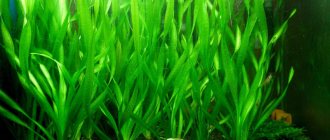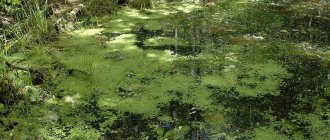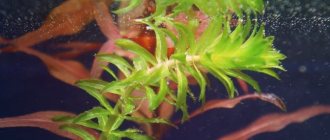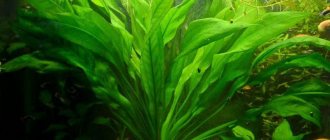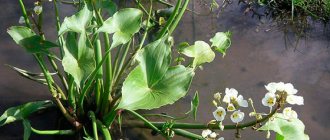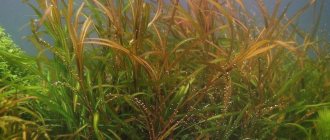Among the representatives of the underwater world, Bacopa Monnier has a rich medical past. For many centuries in a row, it has been successfully used in Ayurvedic medicine, but under a different name. In Asia the plant is known as Brahmi.
In Europe and Russia it is more valued for its decorative qualities. Juicy fleshy bushes look impressive in the middle ground. Bacopa blooms beautifully, pleasing the eye with elegant white and blue bells.
This creeping perennial herbaceous plant can grow both submerged and above water. In the right environment it is considered spiritual. Due to its powerful and multi-directional healing qualities, it was named after the god Brahma. The first written mentions date back to the 6th century.
The genus Bacopa includes about 100 different species of aquatic crops. Such an unusual name was borrowed from the vocabulary of the aborigines of Guyana, located in South America. In addition to Bacopa Monnieri, Bacopa Caroline is especially popular among aquarists.
Morphological features:
- Family - Norichnikovs, according to an alternative classification, belongs to the Podorozhnikov family. Genus - Bacopa.
- The stem is thin, strong, erect in the submerged state, and spreads along the ground in the air. It reaches a length of 25 to 40 cm.
- Leaf arrangement is opposite.
- The leaves are fleshy, small, oblong, oblanceolate with a serrated edge. They grow from the base to the top of the stem. When crushed, a rich lemon aroma appears.
- Leaf color is olive green.
- The flowers are small, bell-shaped, white or blue.
There are several decorative varieties, among which the most popular are “Low-growing” (“Compact”) and “Broad-leaved” (“Round-leaf”). The first hybrid has elongated lanceolate leaf blades and a miniature size, while the second has succulent, rounded foliage.
Although this plant is not considered a pharmacopoeial plant according to the position of official medicine, it is incredibly popular among herbalists adhering to the Ayurvedic tradition.
Asian healers use it as a natural tonic, analgesic and add it to soothing preparations and nutritional supplements.
There is a version that thanks to Bacopa Monya, ancient Vedic experts were able to memorize long fragments of sacred texts.
Bacopa: what is it and what does the flower look like?
Bacopa Monnieri is a small-leaved herb. Leaves and inflorescences are amorphous and small. The number of petals is up to 5. The soft green leaves have an oval, spoon-shaped shape and a glossy surface. The stem length is from 20 to 40 cm. The flowers of the crop are white or pink.
Bacopa pleases the eye with delicate, graceful blooms
Outside the flowering period, the branches look rather faded and unattractive, but the appearance of the grass changes radically when many small, neat flowers appear on it.
Features of reproduction
The seed method is quite labor-intensive and not always effective.
But the plant is easy to propagate by stem cuttings. To do this, the upper shoots need to be planted in the soil, without deeply rooting the lower whorl.
After roots at least 5 cm long have formed at the base of the leaf blades, the bush can be replanted.
Temperature
Medicinal properties of the tricolor violet flower - description of the plant
Bacopa Monieri is not picky about the ambient temperature. It feels comfortable at high and low temperatures, withstanding frosts up to 50 °C. But in winter, grass grown in flower pots must be moved to a warm room.
Attention! If grass is growing in an aquarium, the water temperature should be between 22-25°C.
In the underwater world of the aquarium, bacopa looks especially attractive
Name variations
Bacopa Monnieri has several alternative names:
- Bacopa Manieri;
- moneywort;
- Avran Monier;
- Water Hyssop;
- Herpestis Monnieri;
- Indian penny;
- Webeynik Monier;
- Indian shieldwort;
- Brahmi;
- Leafy auran;
- Brahmi;
- Grass of Grace;
- Aindri;
- Water hyssop;
- Moneywort.
Until 2010, Bacopa Monnieri was referred to as Salzman's Hediotis. Subsequently, it turned out that the same plant was sold under 2 different names. Land species of Bacopa are called Sutera.
Feeding
You need to fertilize the grass in spring and summer, alternating the use of mineral and organic fertilizers. Only young plants are fed. Frequency: 1.5-2 times a week.
Mineral fertilizers – nitrogen, and those containing magnesium and manganese. These components promote abundant flowering and increase the flower’s immunity. Organic fertilizers use solutions of bird droppings or mullein.
Important! When applying fertilizers, do not allow them to fall on the leaves. Otherwise, the plant will get burned.
Indications
Taking bacopa is indicated for the following diseases and conditions:
- cardiovascular diseases, including arterial hypertension, post-stroke rehabilitation;
- diabetes;
- prevention and treatment of certain types of cancer (breast, skin, colon);
- neurodegenerative disorders: Alzheimer's disease, Parkinson's disease;
- chronic and acute inflammation;
- increased psycho-emotional stress;
- decreased cognitive functions of the brain;
- ADHD;
- anxiety, depression, effects of stress;
In reviews, consumers note that they successfully use bacopa for performance, to enhance concentration, improve memory and attention . Bacopa is approved for children over 5 years old, so it will effectively help overcome increased intellectual stress during learning, which is especially important for children with ADHD and other nervous dysfunctions.
How does it reproduce
Bacopa is propagated by seeds, cuttings and by air grafting.
Germination of seeds
Seeds are planted in March. Procedure:
- Fill the container with nutrient soil and water generously.
- Deepen the seeds no more than 1 cm, sprinkle soil on top, and tamp lightly.
- Cover the box with plastic wrap or glass. Place in a warm place, with a temperature of at least 20 °C.
The first seedlings will sprout in 3 weeks. When the seedlings have 3-4 full-fledged leaves, the bushes can be planted in separate pots.
Attention! Before use, the nutrient mixture must be disinfected in the oven for 4 hours.
Rooting cuttings
For wintering, bacopa is brought into the house and placed in a warm room with sufficient sunlight. Such conditions will awaken the flower and it will begin to sprout new shoots. When they grow a little, they can be cut and used for cuttings. In this case, shoots are selected that have at least 2 buds. The optimal length of the cutting is 10 cm. The buds on the shoot should be located so that one of them can be deepened into the ground.
Cut cuttings are placed in water with the addition of a growth stimulator for 2-3 hours. The lower leaves must be removed. For rooting, 2 methods are used:
- The cuttings are left in a container of water, which needs to be changed regularly. As soon as roots appear, the shoot can be planted in the ground.
- The cuttings are buried in a fertile and light substrate up to the growth line. Only the top remains on the surface. The top of the cutting should be covered with a plastic bottle or glass jar.
Attention! Young bushes need to be watered regularly. It is important to begin the formation of shoots in a timely manner so that the flower has a beautiful shape.
Propagation by cuttings is the most popular, easiest method.
Air layering
This simple method allows you to quickly and easily get a new bush. Procedure:
- Place a box with nutritious soil near the container with the mother bush.
- Bend one shoot from an adult flower to the ground in a nearby container, press it into the ground, and secure it with a bracket.
- After some time, remove the layer of soil and see if roots have appeared. If they have formed, the shoot can be separated from the mother bush.
Instead of fertile soil, you can use sphagnum moss, into which the shoot is placed horizontally. Until the root system appears, the flower should be kept in a warm room with high humidity.
Useful lifehacks
To promote better plant growth, we offer advice from practicing aquarists:
- Since Bacopa branches weakly under water, the upper edges of the shoots should be cut off.
- If you press the base of the plant with a stone or driftwood, it can be grown horizontally. When it is firmly rooted, a beautiful emerald carpet will form at the bottom of the tank.
- If roots do not form on a young bush, you need to leave it floating. Over time they will appear.
- Various types of bacopa, placed at different levels around the perimeter of the herbalist, look impressive.
Medicinal properties and contraindications
You need to know that Bacopa Monnieri is not only a beautiful flower for growing in pots and aquariums, but also a medicinal herb. It will be beneficial in the treatment of many diseases. The plant contains the following beneficial substances:
- Apigenin – has a choleretic and antispasmodic effect.
- Quercetin is a powerful antioxidant that has a diuretic, anti-inflammatory and antispasmodic effect.
- Glucoside beta-sitosterol - reduces the absorption of cholesterol in the digestive system.
- Sterol is an adaptogen that promotes better and faster adaptation of the body to new conditions.
- Luteolin is a flavonoid that has choleretic, antitumor, antiallergic and immunomodulatory effects.
- Hersaponin is a sedative that increases the contractile force of the cardiac myocardium.
Bacopa is used to make medicine
Medicinal properties of bacopa:
- Normalizes the functioning of the digestive system.
- Neutralizes the negative effects of alcohol.
- Restores the functioning of the pancreas.
- Evens out hormonal levels.
- Stimulates the process of collagen production, which improves the appearance of the skin.
- Returns the tone and elasticity of the walls of blood vessels.
- Speeds up metabolic processes.
- Improves the functioning of the nervous system.
Bacopa, the properties of which are used in the treatment of diseases, is contraindicated in some cases. The following drugs should not be taken with it:
- people under 18 years of age;
- pregnant women;
- during breastfeeding;
- with bradycardia.
Attention! Bacopa-based products should not be combined with sedative medications and drugs used to lower high blood pressure, with estrogen substitutes.
Bacopa Monnieri is an amazing plant with pleasant flowering that can be grown in an aquarium, creating a wonderful underwater world, and in flower pots, decorating balconies, terraces and gazebos. Caring for bacopa is not difficult, you just need to follow some rules.
Distribution area
Bacopa Monnieri comes from India. According to an alternative version, the aerial form of this plant appeared in the swamps of South America, and the aquatic form grew in the waters of the Canary Islands. This beauty can be found on all continents with the exception of Antarctica, mainly in the subtropical and tropical zones. It grows everywhere in the Indian states, Nepal, Taiwan, China, Vietnam and Pakistan.
Prefers the shores of lakes and rivers, as well as the brackish coasts of mangrove forests. Depending on the time of year, it is either submerged or lining shoots along the moist soil. In aquarium farming, laboratory-grown cultures are used.
Placement in an aquarium
Bacopa of this type is recommended to be planted in low, small “jars”. It is easier to place Moniera in an aquarium, planted in a pot with soil, in which it will be healthier and the leaves and stems will be thicker. It is wise to place the pots near a natural light source or next to a lamp. Bacopa monnieri looks attractive in the corners of the aquarium, especially since it grows quickly and occupies the entire corner area.
If you place bacopa in the foreground, then it will not look very elegant there. Individual branches also look rather faded. To enhance branching, cut off the upper edges of the shoots. To create an aquascape, group planting of moniera bushes is used. Groups look better when arranged in a stepped order. This allows you to create the effect of dense thickets, which will decorate the aquarium and serve as a shelter for the fish from bright light.
FAQ
Question: Can bacopa be given to children?
Answer: Unlike gingo, bacopa can be given to children from 5 years old at 200-250 mg per day. It is important to consult your doctor and follow the recommended dosage.
Question: What is better: bacopa in tablets or brewing the plant as tea?
Answer: The tablet form contains a plant extract standardized to contain a certain percentage of bacosides. This form is more effective and is taken for medicinal purposes. Tea is suitable for prevention.
Question: Can I take bacopa long-term? Will there be an overdose or side effects?
Answer: It is not recommended to take this herb for more than 3 months in a row. It is better to take a break and then resume treatment.
Rest period
Bacopa monieri goes dormant during the winter months. Care at such times becomes less intense; flowers need to be provided with comfortable conditions:
- being in a warm (20 °C) room where temperature changes are minimal;
- placement in a place protected from cold winds and drafts;
- regular watering (if it does not grow in an aquarium) in order to maintain constant soil moisture.
Bacopa flowering
For your information! Careful adherence to dormancy will ensure flowering and preservation of open buds even in winter.
Recommended combinations
Reviews of taking bacopa contain recommendations for combining the herbal medicine with other remedies:
| Medications in addition to bacopa | Effect |
| Gingo biloba | Neutralizes inflammation in the brain, improves blood circulation, eliminates headaches. |
| Magnesium; calcium; reishi mushrooms. | Eliminating severe depression, neutralizing the effects of stress, improving mood |
| Gotu Kola. | Significant improvement in cognitive function |
| Cognitex; magnesium; vitamin B complex; taurine. | Improving memory, concentration, attention, increasing mental performance. |
| Vitamin C. | Rejuvenation of the body, strengthening of the nervous system |
Drug interactions
Interactions of Bacopa are possible when taken together with the following medications:
- drugs modified by the liver;
- agents for the treatment of Alzheimer's disease;
- anticholinergic and cholinergic drugs;
- acetylcholinesterase inhibitors;
- thyroid hormones.
Bacopa from Nature's Answer
Lighting
Bacopa ampelous - growing and care at home
The plant needs bright light. Natural sunlight will be useful; scattered indirect rays have a beneficial effect on Bacopa monnieri. Daylight hours for a flower should last at least 12 hours. The lack of natural light is compensated by artificial lighting.
Additional lights will speed up the development of the bush. The optimal substitute for the sun is fluorescent sources; in some cases, ordinary incandescent lamps are suitable.
Description
Bacopa small-leaved is a herbaceous plant from the Norica family. The natural distribution environment is swampy places in the humid tropics and subtropics of America, Africa, Asia and Australia.
Monieri can be either creeping or erect, growing up to 25-45 cm. The latter is mainly used by aquarists. This is a plant with cruciformly opposite leaves, sessile or with inconspicuous petioles. The leaf blade is narrow, spade-shaped with a rounded tip. The foliage is fleshy with a bare surface and the same stem. It is quite strong, and therefore does not bend well. There are no aerial roots on the stem, therefore there are no shoots (they grow from the root).
On a note! Monier is propagated vegetatively. Overgrown tops 10 cm long can be planted directly into the ground before roots appear, deepening the first whorl of leaves.
Humidity
Flowers are primarily sensitive to this parameter. If the plant does not grow in an aquarium, but in a pot outdoors, care should be taken to ensure that both the soil and the air around the bush are constantly moistened.
In dry air, the stem and leaves of the flower will also dry out, and a lack of water in the soil will lead to stunted growth and weakening.
To maintain a comfortable climate, the container with Bacopa monieri can be placed in a special room or a transparent container that maintains the necessary conditions (for example, a sealed glass or plastic cabinet).
The best drugs from iHerb
We invite you to familiarize yourself with the best products with Bacopa monnieri according to consumer ratings, and also find out the prices for Bacopa from our table:
| Drug name | Consumer rating (number of reviews / average score) | Compound | Efficiency evaluation by buyers | Product volume, price |
| Himalaya, Bacopa, 750 mg, capsules | Best Bacopa Supplement According to Consumers 249 / 4,1 | 1 capsule contains: 500 mg bacopa powder (10 mg, 2% bacosides); 250 mg bacopa extract (60 mg, 24% bacosides) | Increases mental activity, calms, eliminates anxiety and depression. Improves sleep, prevents dementia, good for memory. | 60 capsules – $16.98 |
| Nature's Answer, Bacopa, 500 mg, capsules | 147 / 4,2 | 1 capsule contains: 100 mg bacopa extract (20% bacosides), 400 mg Bacopa monnieri leaf powder | Helps against headaches caused by inflammation of the brain. Improves cerebral circulation and memory, calms, increases concentration. Eliminates depression, neutralizes stress, alleviates epilepsy. | 90 capsules – $12.74 |
| Paradise Herbs, Bacopa, 250 mg, capsules | 93 / 4,2 | 1 capsule contains 250 mg of organic bacopa leaf extract | Helps the body cope with stress and improves memory. Helps well with migraines, depression, cognitive disorders. | 60 capsules – $12.49 |
| Doctor's Best, Bakopa with Synapsa, 320 mg, capsules | 39 / 4,0 | 1 capsule contains 320 mg of Bacopa extract (55% bacosides) | Improves concentration, functional thinking, eliminates forgetfulness, and increases the academic performance of schoolchildren. | 60 capsules – $16.26 |
| Herb Pharm, Bacopa, liquid extract | 22 / 3,9 | 0.7 ml contains 647 mg of bacopa extract (140 mg herb) | Clears the mind, helps cope with stress, improves mood, eliminates depression. | 30 ml – $15.00 |
Regular customers of the iHerb online store note the advantages of ordering dietary supplements on this site:
- wide range - more than 300,000 items;
- responsible delivery to 150 countries;
- availability of goods with a long shelf life;
- original quality guarantee;
- discounts, special offers;
- low prices.
Common varieties
Brahmi can grow both in open ground or a pot, and in an aquarium. Most varieties are adapted to being in both aquatic and air environments. The types of bacopa available for purchase are grown in the Netherlands:
- Carolina. A plant of North American origin grows in the wild from water into the open air. The height of the stems is up to 30 cm. Blue or bluish flowers sprout at the ends of the branches. The shoots are covered with dark green or orange elongated leaves;
- Australian - a variety from the warm southern lands, growing in an aquatic environment. The branches are strewn with pale green round leaves, the flowers are light blue;
- spreading develops on the earth's surface in a humid climate. Forms a bush in the form of a ball. The buds open in summer, the petals have different shades: bright pink, blue or light blue, milky white;
- Olympic Gold and Bluetopia are species adapted to grow in pots. Bred by breeders as the most flowery. Flowers differ in shades: Olympic gold blooms double snow-white buds, Blutopia - light lilac or blue.
Olympic variety
Note! Descriptions of varieties may differ from actual appearance, since small-leaved bacopa adapts to environmental conditions and is capable of changing the color and shape of leaves.


